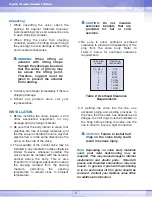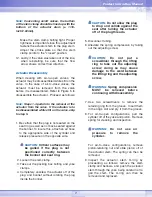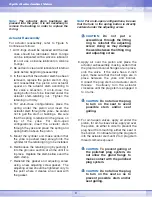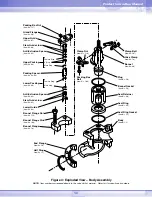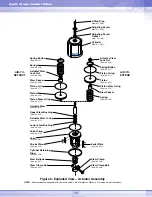
4
impede stem movement.
7. Be sure that all accessories, brackets, and
bolts are securely fastened.
8. Check rubber bellows for wear.
9. Remove any foreign substances from the
plug system.
10. Spray a soap solution around the cylinder
actuator that retains the ring, adjust screw
and actuator stem guide for air leaks
through the O-rings.
11. If possible, remove air supply and observe
actuator for correct fail-safe action.
12. If the valve contains an air filter, check and
replace cartridge if necessary.
13. Be certain that stem clamp and positioner
linkage are securely fastened. If the stem
clamp is loose, check the plug thread
engagement. (For the correct procedure
on aligning the plug with the seat, refer to
the "Reassembly of the Actuator" section of
this manual).
14. Stroke the valve, if possible, and check for
smooth, full stroke operation. Wobbly stem
movement could be a sign of an internal
valve problem.
Note:
Erratic stem movement is common
whenever Grafoil packing is utilized.
WARNING:
Keep hands, hair,
clothing, etc. away from all
moving parts when operating
the valve.
ASSEMBLY AND DISASSEMBLY
Body Disassembly
In disassembling the valve body, refer to Figure
4 and continue as follows:
WARNING:
Depressurize line to
atmospheric pressure and
drain all fluids before
commencing work on the valve.
1. If valve is air-to-close, skip to step 2. If
valve is air-to-open, apply air under piston
to raise the plug off the seat before taking
the valve apart.
2. Take out the bonnet flange bolting which
will allow for removal of the actuator,
bonnet, and plug from the valve.
CAUTION:
Heavy actuators may
require a hoist. A lifting ring is
provided on most valves for
this function; otherwise, lift the
valve with the yoke legs using a
lifting strap and a hoist. Care
should be taken to lift the
actuator and plug straight out
of the body to avoid damage to
the seat as well as to the plug.
3. Lift retainer, seat ring, and gaskets from the
body.
4. See to it that the seating surfaces on both
the seat ring and plug are free of damage
so that a tight shutoff is ensured. Be sure
that gasket surfaces on the seat ring,
bonnet, and body are clean and
undamaged.
5. To inspect the plug, remove by loosening
the stem clamp and gland flange, also, take
off the yoke clamps.
Note:
With air-to-close, fail-open valves, it
may be necessary to apply a small amount of
air to the top of the actuator to move the plug
away from the bonnet. If not, some irritation
may occur to the plug.
Turn the actuator off the plug and bonnet
without allowing the plug to rotate inside the
bonnet. Remove the plug carefully through the
packing box.
6. If re-machining is necessary on the seat
surfaces, both surfaces on plug and seat
must be reworked. The seat angle on the
plug is 30 degrees; the seat ring is 33
degrees. Lapping will not be necessary if
proper assembly procedures are followed.
Op
G
L
G
lobe Control Valve


